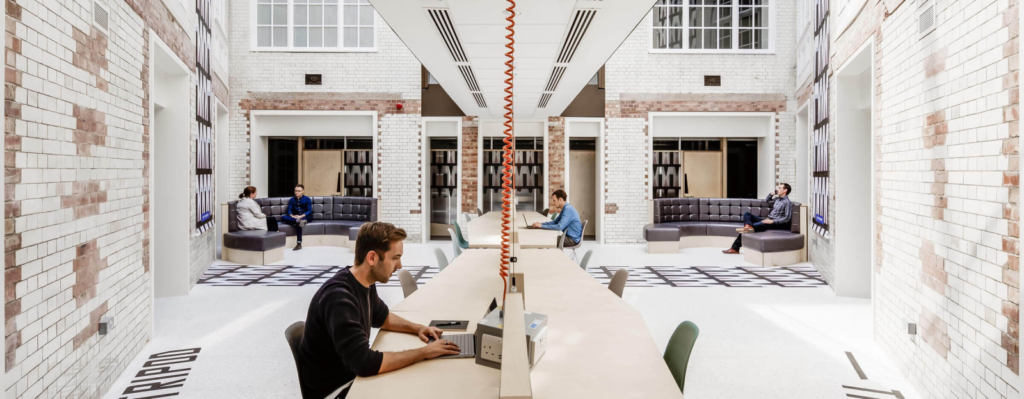THE NEW CIVIC SPACES: HOW TOWN HALLS ARE CHANGING WITH US
THE NEW CIVIC SPACES: HOW TOWN HALLS ARE CHANGING WITH US

Close your eyes and think of a civic space. Many of you might bring to mind a town hall, or city chambers – somewhere that’s formal, possibly a bit dark, with lots of stairways and corridors, or grand seating for council debate. All the traditional markers for places where people come to engage in public life, democratic process, local government administration. But these days, civic space is changing dramatically to reflect communities’ evolving needs.
As we better understand the diverse and complex needs of society, civic spaces are adapting to different priorities, in order to remain relevant and effective, and to accommodate a wider range of functions and activities. Their evolution is providing new opportunities for community engagement and participation. It’s also providing new opportunities for ways of local government working as leaders respond to pressure on services with a drive to create modern spaces that can attract a forward-thinking workforce.
Recalibrating what we mean by ‘civic spaces’ is helping not just to build prosperous, inclusive places that provide better futures for everyone, but also to design better offices and interiors that demonstrate how local authorities and city governments recognise the importance of workplaces that are not just functional but also inspiring, collaborative, and healthy. When employees have access to collaboration spaces and flexible workstations, they are more likely to work together on projects and come up with the creative solutions to today’s problems.
One major change in the nature of civic spaces has been a shift to facilitating community events in order to support shared community spirit and identity. Civic spaces are now often used to host cultural events, music festivals, and public art installations in a growing recognition by local leaders that social interaction and celebration is as important as bureaucratic processes to local people. For example, an ICC project includes the recently refurbished and relandscaped Waltham Forest Town Hall campus is a place for people – where residents, workers and visitors alike come together to enjoy a place that is active, inclusive and welcoming, including an interactive water feature that encourages children and families to play in the water on a hot day while also being flexible to accommodate large scale events, from Diwali fireworks to community festivals. This new public space, in the heart of the borough, has introduced a communal, shared space for the diverse community to celebrate and turn a forbidding grounds into a place for all.
Tunstall Town Hall, in Stoke-on-Trent, demonstrates further how local authorities are rethinking their space in a way that responds to community need. In the national context of a squeeze on childcare access and spaces, Stoke-on-Trent City Council incorporated childcare facilities into its workplace design. The town hall building now features a state-of-the-art nursery that provides care for the children of employees, allowing parents to remain close to their children while they work.
Another important shift has been the increasing inclusivity of civic spaces. Historically, many were exclusive, catering only to certain segments of the population. In recent years, there has been a push to make these spaces more accessible and welcoming. This has included efforts to create more wheelchair-friendly entrances and seating, as well as the provision of interpretation services for those who do not speak the dominant language of the community. Camden’s recently restored Old Town Hall has included wheelchair accessibility and improved lift access and public spaces to allow for differently-abled people. As Town Halls and Civic Spaces across the country create more inclusive places, we recognise that many places still need more to do, no less at some of the country’s most famous spaces.
Furthermore, civic spaces are increasingly becoming platforms for civic engagement beyond the traditional democratic process – places for people to come together and work towards common goals, such as advocating for social justice or addressing environmental issues. This type of civic engagement is known as “civic hacking” or “participatory design,” and it involves citizens collaborating with each other and with government officials to co-create solutions to community problems. In 2021, Madrid’s City Council created a new Department of Citizen Participation and welcomed residents into City Hall to use a platform called Decide Madrid, which allows registered users to discuss topics with others in the city, propose actions for the City Council, and submit ideas for how to spend a portion of the budget on projects voted on through participatory budgeting.
Designing good local government means not just working with local communities but also recruiting top local talent – which in turn means creating the kind of spaces that invite bright minds. One great example of this is Lambeth Town Hall in London. The building underwent an award-winning renovation in 2021, which included a complete overhaul of the interior design and a new, flexible use addition and refined Civic Quarter. Now modern, open-plan offices feature collaboration spaces and flexible workstations to encourage creativity and teamwork – all under bright natural light and bursting with greenery.
Hackney and Tower Hamlets Town Halls provide further examples of civic space where local authorities have invested in the working environment. The former’s recent renovation incorporated sustainable materials and energy-efficient systems, as well as a range of spaces designed to promote health and wellbeing, such as an on-site gym and rooftop terrace. The latter’s design includes an abundance of natural light and greenery, as well as spaces designed for relaxation and meditation. Both demonstrate employers’ increasing understanding that when employees feel valued and comfortable in their workspace, they are more likely to stay and be more productive while they are there. Natural light, greenery, and access to spaces for relaxation and meditation can all help reduce stress and promote mental health.
The importance of inclusive spaces, great interior design, and an open civic heart cannot be overstated. Local authorities and city governments are leading the way in creating inspiring public spaces and workplaces that promote collaboration and innovation, and the health and wellbeing of their workforce and local people. This is not just a passing fad, but a fundamental shift in the way we think about “civic” spaces to work, enjoy, and learn. There’s a lot more of this work ahead of us to enjoy.

